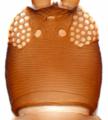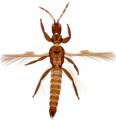Aeolothrips vittipennis
Recognition data
Distinguishing features
Both sexes fully winged. Body and legs uniformly brown; female with antennal segment III yellow with apex more or less brown, segment IV yellow in about basal half and brown distally; fore wings with posterior margin dark from apex and including clavus, medially extending to or beyond first longitudinal vein and sometimes to costa. Head with no long setae; pronotal posteromarginal setae stouter than pronotal discal setae. Fore tarsus apically with stout recurved ventral hamus. Antennae 9-segmented, segment III with linear sensorium about 0.3 as long as segment, IV with sensorium more than 0.5 as long as segment and curved at apex, V–IX forming a single unit with V much longer than VI–IX. Metanotum reticulate. Median two pairs of marginal setae on sternites arising at or close to margin, lateral two pairs displaced onto disc; sternite VII supernumerary paired setae small and arising sub-marginally.
Male with antennae darker, segment III fuscous; fore wing with median dark band extending fully across wing; tergites IV–V without paired tubercles; tergite IX without claspers or stout setae.
Related and similar species
A. vittipennis is one of a group of North American species in which the posterior half of the forewing is dark, but unlike most of these species the dark area extends from the wing apex to the clavus. Just over 90 species are placed currently in the genus Aeolothrips, of which more than 50 are from the Palaearctic Region (mainly Europe), and 28 from the Nearctic (mainly western USA). Only two species are recorded from the Neotropics; the one from Chile is probably the same as A. fasciatus, and one from Panama is probably not a member of this genus (Mound & Marullo, 1996).
Taxonomic data
Current valid name
Aeolothrips vittipennis Hood
Original name and synonyms
- Aeolothrips vittipennis Hood, 1912: 129
- Aeolothrips floridensis Watson, 1916: 126
- Aeolothrips oculatus Hood, 1927: 125
- Aeolothrips yosemitae Moulton, 1929: 125
Family placement
Aeolothripidae
Biological data
Life history
Presumably flower-living as a facultative predator with a mixed diet of pollen and the larvae of other thrips.
Host plants
Adults have been collected from a wide range of flowering plants and grasses, but with no indication of any larval associations.
Tospoviruses vectored
None
Crop damage
None recorded
Distribution data
Area of origin
USA
Distribution
Originally described from Illinois, this species was further described under three names from Florida, Colorado and California that are now considered to be synonyms. It is reported as widespread across North America, and specimens have also been studied from Guatemala. A closely related species, A. mexicanus Priesner from Central America (Mound & Marullo, 1996), apparently differs in having the median dark band on the forewing complete across the wing in females.








